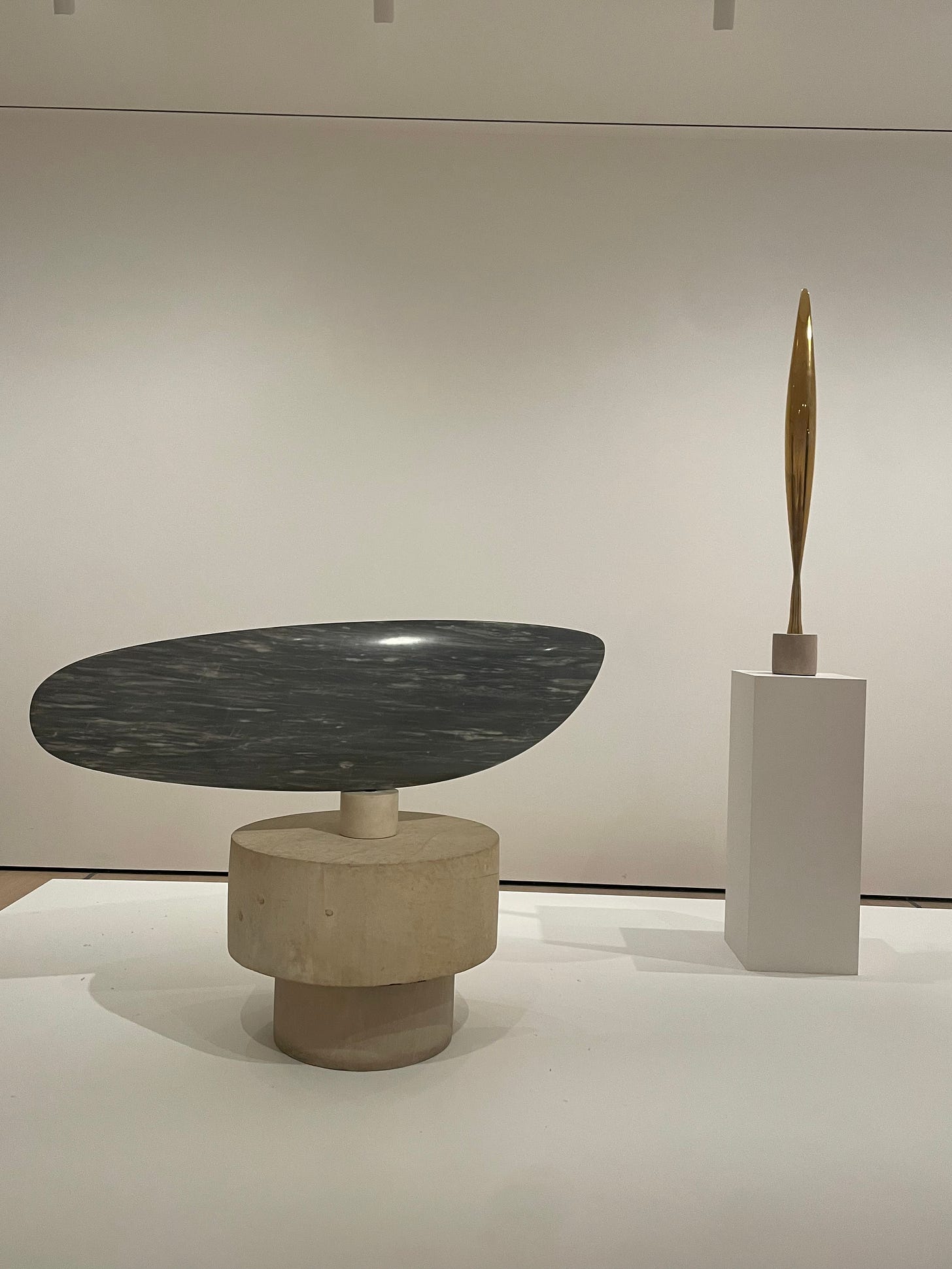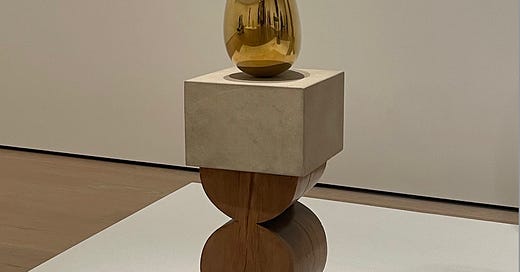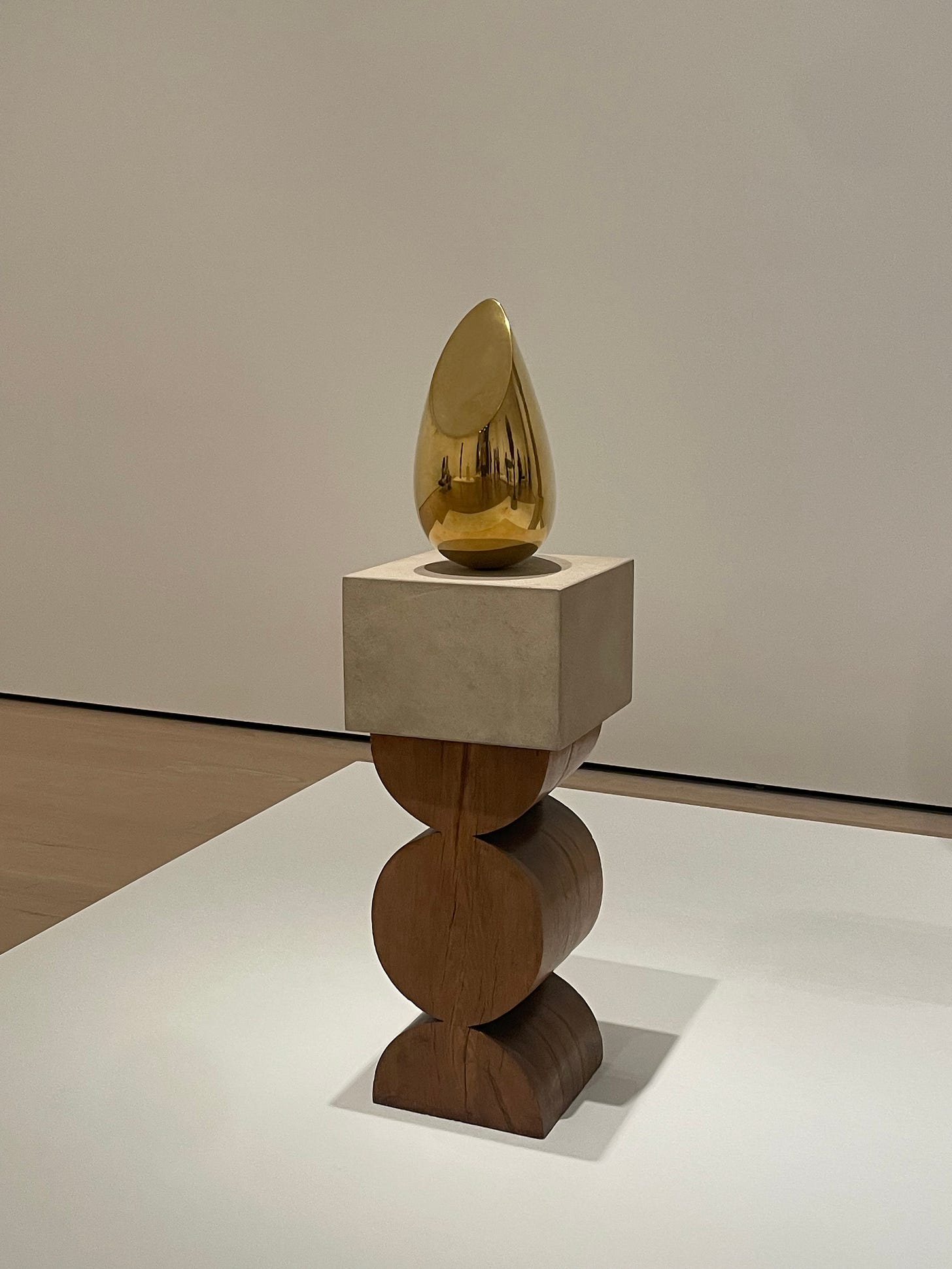Touring the top floor of the MoMA’s permanent collection in New York this weekend, I was struck by the symmetry of a Brancusi sculpture, so I photographed it. I of course liked Van Gogh’s The Starry Night, as well as, naturally, Claude Monet’s Water Lillies, but the first art object I felt compelled to photograph was the Brancusi.
A few hours after I photographed it, a friend commented that the work looked like a Beauty Blender before rushing to clarify that he indeed liked it. Though it was created exactly eighty years before the release of the Beauty Blender, Brancusi’s Young Bird does bear a certain resemblance to the storied makeup tool. The comparison was apt.
Yet why the need to clarify that he liked it? Did the comparison to a utilitarian object inherently negate the beauty of the work? In what way had he trespassed, exactly, in comparing such an artwork to something so quotidian? Had he criticized the work? Had he mocked it?
Actually, conflation of Brancusi’s work with utilitarian objects is nothing new. Just ask the U.S. justice system.
In 1927, the U.S. court questioned whether Brancusi’s works were liable for duties as manufactured objects when photographer Edward Steichen attempted to transport Brancusi’s work Bird in Space to the States. Initially, the question at hand was whether the work accurately imitated a bird in space, or a bird in flight; if the sculpture could credibly be attributed to representing a bird flying in space, Brancusi’s work would not face import taxes. Once the trial was well underway, though, it became clear that the task of the court was not to determine how accurately Brancusi imitated the flying bird, but rather how sculpture and art should be defined and measured in the first place.
The court ruled in Brancusi’s favor in Brancusi v. United States a year later, in 1928. It was decided that Brancusi’s sculpture was indeed art—not a utilitarian object that came with import duties. In an era in which abstraction was increasingly gaining currency, the court admitted that times were indeed a-changin’, and that not all works of art could be defined by what they strove to imitate.

So Brancusi’s work was not necessarily a true-to-life imitation. Or if it was, it didn’t matter, because art was no longer about that. But what was it about then?
The role of imitation in art has been debated since at least the time of Plato. There is the oft-quoted Oscar Wilde line that “Life imitates Art far more than Art imitates Life” in response to the Platonic belief that art imitates life. I would argue against both Wilde and Plato, and instead, or perhaps additionally, assert that art imitates art.
In the Guggenheim’s bio of Constantin Brâncusi—the museum held the first retrospective of his work in 1955—they write: “Brancusi secured a position in Auguste Rodin’s studio in 1907, but soon parted ways with the established sculptor, claiming, ‘I felt that I was not giving anything by following the conventional mode of sculpture.’” Brancusi left the establishment explicitly because he did not want his work to be redundant, even if the person he wanted to avoid imitating—Rodin—was the “father of modern sculpture.” The result is that Brancusi is today considered the “patriarch of modern sculpture.”
The word “patriarchy” is Greek for rule of the fathers. Why then, upon leaving Rodin’s studio for independence’s sake, did Brancusi become patriarch? Why did he not become the son of modern sculpture? The stepson? As Leo Strauss once said, “The philosopher is then not, as Hegel said, the son of his times, but the stepson of his times.” Why isn’t Brancusi considered the stepson of modern sculpture?
The answer is simple. Brancusi is known as the patriarch of modern sculpture because he achieved great artistic heights independently of Rodin. Great artists do not succeed one another. Just because Brancusi studied under Rodin does not mean that his work follows Rodin’s—it simply means that Brancusi studied under Rodin. Brancusi is known as the patriarch of modern sculpture because the point of art is to inspire more art—not to imitate and elaborate on prior works.
Brancusi did not cement Rodin’s rule and then work within his sphere like some lesser prince; he learned what he could from Rodin’s rule and then began his own reign.
The point of art is to inspire more art.
What is it about Brancusi’s work that allows him to stand as Patriarch, rather than son or stepson, alongside Rodin as Father without being derivative of his former teacher or imitative of a utilitarian object like a Beauty Blender? The answer lies in the derivation of the word itself.
The word “derivative” can be defined simply. Something “derivative” is something based on something else. Synonyms of the word, however, are less kind; they define themselves negatively, often with the prefix “not” attached to them: Unoriginal, unimaginative, uninspired, uninventive. These definitions are incredibly blasé. They are passive at best, reductive at worst.
The key to understanding Brancusi v. United States lies in the act of replacing the prefix “un-” with “anti-". An artist’s work is derivative if it is not original, not imaginative, not inspired, not inventive. But if an artist’s work is expressly against originality, against imagination, against inspiration, against invention, then it is not derivative. Then it is saying something! Brancusi did not win his case because the judges found his imitation of a bird in flight convincing at last. He won it because the judges finally understood he was against imitation, just as he understood himself to be against emulation. Brancusi’s artistry lies in his opposition.





I love this post. First off, like all good art history, your contextualizing makes me appreciate the work more. And any post with a reference to Leo Strauss, even in passing, is a post worth reading. And by your own definition, this substack is a work of art because it near commands a response from me. It seems that Brancusi was suffering from the anxiety of influence and had to take drastic action to avoid succumbing to the presence of greatness. I am curious if you think that this makes Rodin less of a great artist by your own definition?